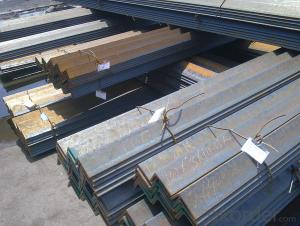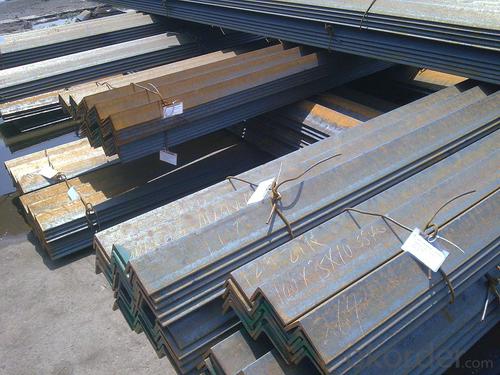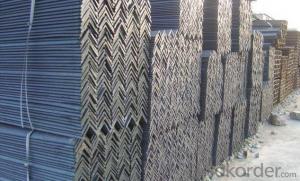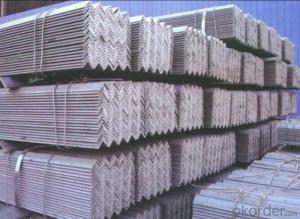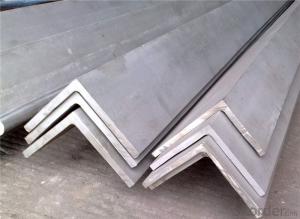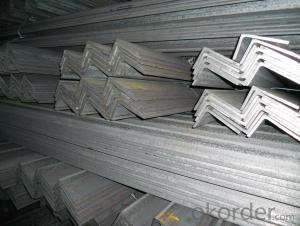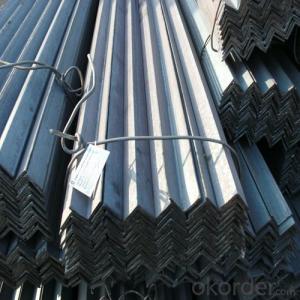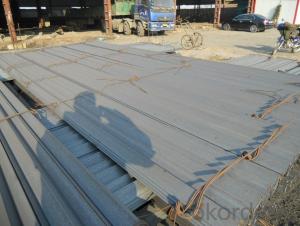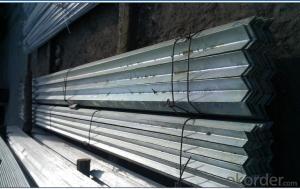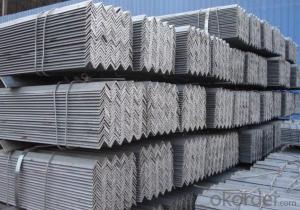Chinese Supplier Hot Rolled Unequal Steel Angle
- Loading Port:
- China main port
- Payment Terms:
- TT or LC
- Min Order Qty:
- 50 m.t.
- Supply Capability:
- 200000 m.t./month
OKorder Service Pledge
OKorder Financial Service
You Might Also Like
Description of Chinese Supplier Hot Rolled Unequal Steel Angle
Length: 6m,9m,12m or as required
Standard: GB/T 9787-2008,GB/T 706-2008, JIS G3101,ASTM
Material: Q195, Q215, Q235, Q345, SS400, A36
Unequal Angle
75×50×6-8 |
90×56×6-8mm |
100×63×6-8-10mm |
100×80×8-10mm |
125×80×7-8-10-12mm |
140×90×8-10-12mm |
180×110×10×12-14mm |
100×75×7-9-10mm |
125×75×7-9-10-12mm |
150×90×8-9-12mm |
Payment Terms: TT, L/C
Packing: Standard seaworthy bundle packing or as required
Application of Chinese Supplier Hot Rolled Unequal Steel Angle
widely used in a variety of architectural and engineering structures,such as
a.) beams, bridges, ship;
b.) transmission tower, reaction tower;
c.) lifting transportation machinery;
d.) industrial furnace;
e.)container frame, warehouse goods shelves, etc
Packaging & Delivery of Chinese Supplier Hot Rolled Unequal Steel Angle
1. Transportation: the goods are delivered by truck from mill to loading port, the maximum quantity can be loaded is around 40MTs by each truck. If the order quantity cannot reach the full truck loaded, the transportation cost per ton will be little higher than full load.
2. With bundles and load in 20 feet/40 feet container, or by bulk cargo, also we could do as customer's request.
3. Marks:
Color mark: There will be color marking on both end of the bundle for the cargo delivered by bulk vessel. That makes it easily to distinguish at the destination port.
Tag mark: There will be tag mark tied up on the bundles. The information usually including supplier logo and name, product name, made in China, shipping marks and other information request by the customer.
If loading by container the marking is not needed, but we will prepare it as customer request.
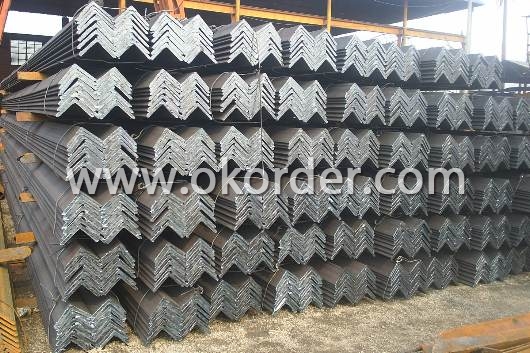
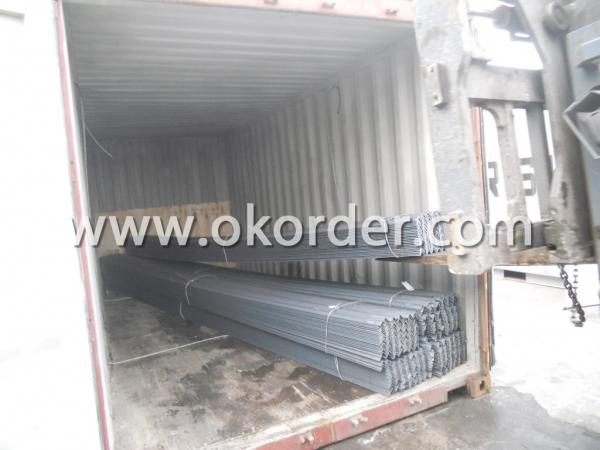
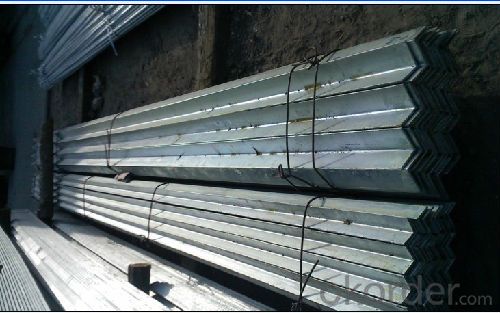
- Q: What are the different uses for stainless steel angles?
- Stainless steel angles have various uses in different industries. They are commonly used as structural components in construction, providing stability and support to buildings and infrastructure. Stainless steel angles are also utilized in manufacturing processes, such as fabrication of machinery, equipment, and vehicles. Additionally, they find application in architectural designs, for creating decorative elements, handrails, and furniture. Overall, stainless steel angles are versatile and durable, making them suitable for a wide range of applications.
- Q: Are steel angles suitable for earthquake-resistant structures?
- Because of their high strength and ductility properties, steel angles are often used in earthquake-resistant structures. Their angular shape enables them to effectively withstand lateral forces resulting from seismic events. Steel angles have the capacity to absorb and disperse energy during earthquakes, making them suitable for withstanding the dynamic loads produced by ground movements. Moreover, connecting and joining steel angles is a straightforward process, which guarantees a high level of structural integrity and overall stability in buildings. These factors contribute to steel angles being a preferred option for earthquake-resistant structures, as they provide a dependable and long-lasting solution for minimizing the impact of seismic events.
- Q: What are the different types of connections used for steel angles in steel frames?
- There are several types of connections used for steel angles in steel frames, including welded connections, bolted connections, and riveted connections. Welded connections involve fusing the angles together using heat, creating a strong and permanent bond. Bolted connections involve using bolts and nuts to secure the angles together, allowing for easy disassembly if necessary. Riveted connections involve using rivets, which are metal pins, to hold the angles together by forming a permanent, tight fit. The choice of connection type depends on the specific requirements of the steel frame and the desired level of strength and durability.
- Q: What is the use of angle steel and channel steel?
- Used to make steel structures, such as steel staircases, plant supports, etc..
- Q: Can steel angles be used in stair construction?
- Yes, steel angles can be used in stair construction. Steel angles are commonly used as structural elements in staircases to provide support and stability. They can be used as stringers, which are the main load-bearing components of a staircase, or as brackets and supports for treads and handrails. Steel angles are known for their strength and durability, making them suitable for use in stair construction to ensure the safety and longevity of the staircase.
- Q: What is the maximum load capacity for a curved steel angle?
- The maximum load capacity for a curved steel angle would depend on various factors such as the dimensions of the angle, the type of steel used, and the specific application. It is best to consult engineering specifications or consult a structural engineer for an accurate determination of the maximum load capacity.
- Q: What are the different methods for strengthening steel angles?
- Different techniques can be employed to enhance the strength of steel angles, based on the specific necessities and intended uses. The following are several commonly used methods: 1. Heat treatment: To increase the hardness and strength of steel angles, heat treatment processes such as quenching and tempering are frequently employed. Quenching involves rapidly cooling the steel angle after heating it to a high temperature, while tempering includes reheating the quenched steel angle to a lower temperature. These processes minimize brittleness and improve toughness. 2. Alloying: By introducing certain alloying elements like chromium, molybdenum, or nickel, the strength and hardness of steel angles can be significantly augmented. These alloying elements form solid solutions with the iron matrix, leading to enhanced mechanical properties and resistance to wear or corrosion. 3. Cold working: The strength and hardness of steel angles can be increased through cold working techniques such as cold rolling, cold drawing, or cold forming. These approaches involve deforming the steel angle at room temperature, creating dislocations in the crystal structure and boosting its strength. 4. Welding: Strengthening steel angles can be achieved by employing welding methods like fusion welding or spot welding to join them with other steel components. The weld joint often provides additional strength and rigidity to the steel angle structure. 5. Surface treatments: Employing various surface treatments such as galvanizing, powder coating, or painting can improve the corrosion resistance of steel angles, thereby increasing their durability and overall strength. It should be noted that the selection of the appropriate method for strengthening steel angles relies on factors such as the specific steel grade, intended application, and desired mechanical properties. Consulting with a professional engineer or metallurgist is advisable to determine the most suitable method for a particular scenario.
- Q: What is the typical size range for steel angles?
- The typical size range for steel angles varies, but commonly, they range from 1/2 inch to 8 inches in width and thickness.
- Q: What is angle iron?
- Standard Specification for hot-rolled equal angle iron is 2#-20#. It can be divided into two kinds of equilateral angle steel and unequal angle steel, among which unequal angle steel can be divided into two kinds: unequal thickness, unequal thickness and unequal thickness. The dimension of angle iron is expressed by the dimension of the length of side and the thickness of edge. At present, the domestic steel specifications for 2 - 20 cm, to length number number, the same horn steel often have 2 - 7 different edge thickness. Imported steel angles indicate the actual sizes and edges of both sides and indicate the relevant standards. Generally, the length of 12.5cm is larger than that of angle steel, and between 12.5cm and 5cm is medium angle steel. The angle of 5cm is smaller than that of angle steel.
- Q: What is the maximum load a steel angle can support?
- The maximum load a steel angle can support depends on various factors, such as the dimensions of the angle, the type and grade of steel used, and the method of support. However, in general, steel angles are known for their high strength and load-bearing capacity. They are commonly used in construction and structural applications to provide support and stability to various structures. To determine the maximum load a specific steel angle can support, it is necessary to consult engineering tables or reference materials that provide load capacity data for different steel angles. These resources consider factors such as the angle's dimensions (length, width, and thickness), the type of steel (such as mild steel or high-strength steel), and the method of support (such as cantilever or simply supported). It is important to note that the maximum load a steel angle can support is typically determined by conducting tests in a controlled environment to ensure safety and reliability. These tests involve applying progressively increasing loads to the angle until it reaches its maximum load-bearing capacity or failure point. The results of these tests are used to establish load capacity guidelines for engineers and builders. Therefore, without specific information about the dimensions, type of steel, and method of support, it is not possible to provide a precise maximum load value for a steel angle. It is recommended to consult relevant engineering references, structural engineers, or manufacturers to obtain accurate load capacity information for a specific steel angle.
Send your message to us
Chinese Supplier Hot Rolled Unequal Steel Angle
- Loading Port:
- China main port
- Payment Terms:
- TT or LC
- Min Order Qty:
- 50 m.t.
- Supply Capability:
- 200000 m.t./month
OKorder Service Pledge
OKorder Financial Service
Similar products
Hot products
Hot Searches
Related keywords
